Capitalism Lab Beginners Guide – Gameplay Basics
Author: Stylesjl
Scouting Out Your Environment
When you first start a game you should take some time to scout out the map that has been generated for you (it is random each time, even for scenarios). Some important things you will need to keep in mind:
Find out what the Wage Rate of each city is. This is important as it determines how much your assets will cost to build and maintain. Lower wages mean that you pay your employees less and construction costs are lower. Aim to build factories in cities with low wages, as they will be cheaper to produce goods in. On the other hand you should build your retail stores in cities with high wage rates, as that will be where the high income customers will spend the most money on your products.
Check Wage Rates by opening the cities menu and selecting Economic Graphs:
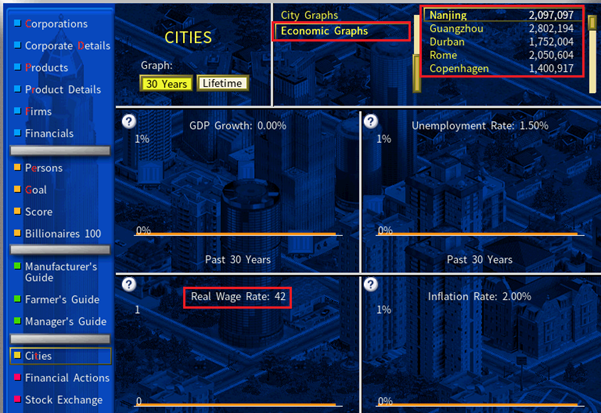
To check the necessity of the product, see the Manufacturer’s Guide:
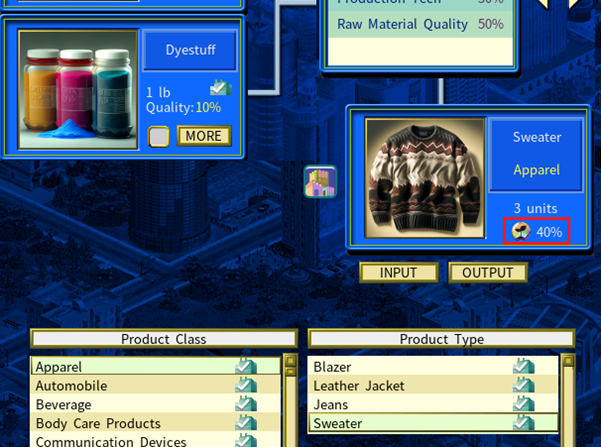
If you need a quick glance in terms of what land in a city is valuable or not, tick the Land Value Overlay when constructing a building. Red/Orange is high value, yellow is mid-value and no colour is the lowest value:
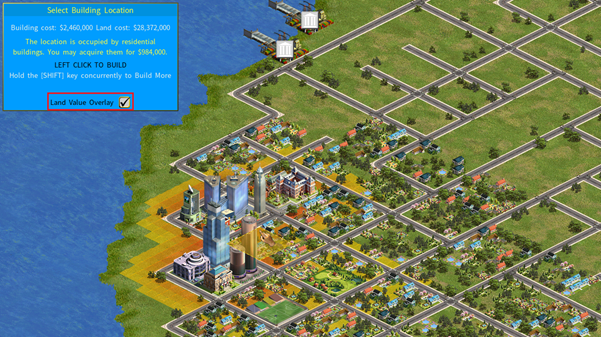
Retail stores should however be always located in busy areas with high customer traffic, even if the land is expensive. Just like the land value overlay, the red and orange areas have high traffic, yellow a middle level of traffic and no colour indicates minimal traffic:
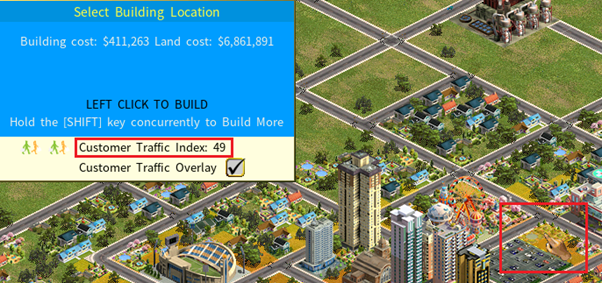
Freight Costs
Be mindful of the freight costs between your farms, factories and retail stores. The further away they are from each other, the higher the cost of freight. The best strategy is to cluster your factories and farms together so that the raw materials and semi-products don’t have as much distance to travel. In addition keeping your factory cluster close to a seaport is ideal as it lowers the freight costs of imported materials and also lowers the freight costs of exports to other cities.
You can check Freight Costs in the Sales Unit of a retail store, where is shows you both the purchase cost charged by the supplier and the freight cost to ship it to the store. Remember that the suppliers don’t pay for the freight or receive any money from it.
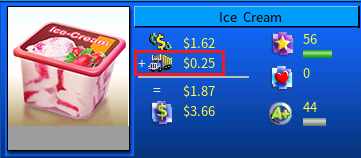
In the case of a factory, you can get a detailed breakdown of the freight cost of each and every input; including the cost of shipping it from one city to another:

Seaports and Competitor Suppliers
The Industrial Seaports are a very useful way to jump start your manufacturing business. If you need certain semi-products to create your own finished products then you should try buying them from the seaports rather than trying to produce them yourself, at least in the early game. Even if only some of the required materials are available at the seaports, you can still save a lot of money by only trying to produce for yourself what is absolutely necessary.
For example this seaport allows you to import Car Bodies. This saves you from having to invest in a Car Body factory. It also saves you from needing to invest in the semi-products and raw materials needed for Car Bodies (Plastic, Glass, Steel, Oil, Silica, Coal and Iron).

If Car Bodies or other car parts are not available from the seaports then breaking into the automobile industry will be more difficult as you will have to pay for all of the factories and mines to produce all of the needed parts; an expense almost always unaffordable at the game start.
Be sure to scout around at the start of every game and make a note of what products every industrial seaport has for sale and strategise accordingly. Game difficulty usually increases when seaport quality is lowered or if there are fewer industrial seaports.
Industrial Seaports are noted with an I on the minimap, C is for a commercial seaport (which sells retail goods).
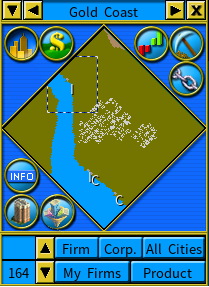
As the game progresses, your competitors will begin to produce their own products and offer them for sale on the open market. It may be cheaper to buy these products from your competitors rather than producing them yourself (especially if the required amount of inputs are low). Very often they will offer higher quality inputs at a better price than the seaports:
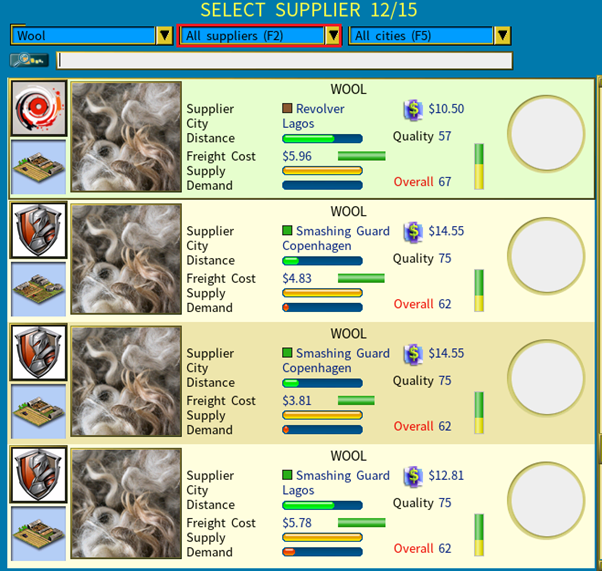
Be careful about reliance on the seaports and competitor suppliers in the longer term. Eventually once you have enough capital you may be able to make better products at a cheaper cost than the seaports and also seaport supplies may eventually stop depending on the difficulty level.
Supply Chain Overlap and Selling to Competitors
If you do choose to become independent of third party suppliers such as competitors or the seaports you may notice that you are producing more products than what you need for your finished goods, for example producing more Electronic Components than what your Computer factories require.
Aside from reducing the output from your factories and farms there are two other ways you can deal with this surplus production:
- Expand into other product categories that use similar inputs.
- Let your competitors buy your surplus production.
In the first case you should check the Manufacturer’s Guide and then try pinning the input you want to look at to see where else that input can be used. An example is shown below for Electronic Components:
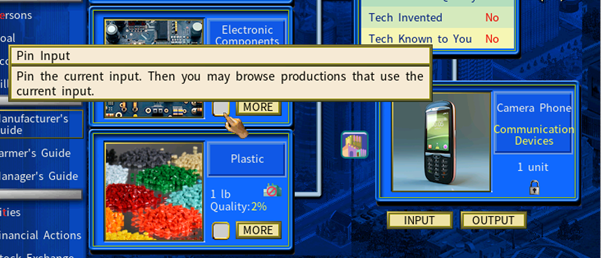
As you can see there are 21 different products that can be produced using Electronic Components as an input! This means that if you run an Electronics factory you can use that same factory as a supplier to a wider variety of products. Of course you do need to produce other inputs as well:
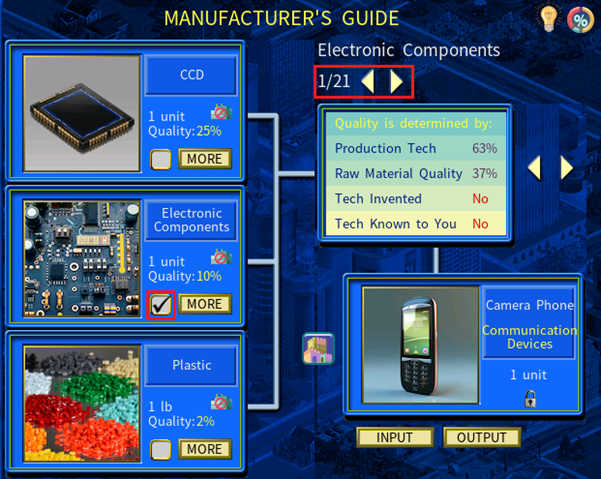
With this information in hand you will notice that some product categories are closely connected. For example Home Appliances all use Electronic Components, same with Electronic and Photography Products. If you have dominated one product category and want to expand, then these would be your next logical targets for expansion, as you already have a large part of the input materials that you need.
Similar overlaps can be found in other areas such as Food and Snacks, Leather and Apparel, etc. Consult the guide to learn more about these potential connections.
The second approach is to sell to your competitors. This will automatically happen as long as your firm does not have Internal Sale set. If your products have a high enough rating (a low price and high quality) then other companies will start buying from your firms. This is generally a good thing in most cases as they will pay you a steady stream of money in exchange for factory capacity that would otherwise go to waste.
You can in some cases skip the retail stage entirely and just let your competitors sell your goods for you (but you will miss out on the retail mark-up).
If you want to know who is buying from you, select View Clients and it will list all of your buyers; along with how much they are buying from you and what they are producing:
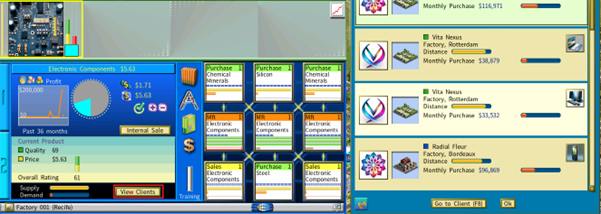
There are some reasons however that you may want to block sales to your competitors (set Internal Sale on)
- You want to conserve resources or they are using too much of your capacity and you can’t expand capacity to keep with their demand levels.
- They are directly competing with you (for example they are buying your high quality electronics to make the same products as you are, undermining your quality advantage).
Keep in mind through that if you set Internal Sale on this will not affect existing supply contracts. You will have to demolish the factory or raise the price to a very high level to stop all existing supply contracts to your competitors.
Debt
Debt is a good way to expand your business. Borrowing money at the start of the game is very useful, as it allows you to effectively double your starting capital by borrowing up to 100% of your current assets. This can allow you to expand your business much further, provided that you can pay the monthly interest. In the example below you can acquire up to 400 million in starting funds (but you will have to pay 15 million in interest per year):
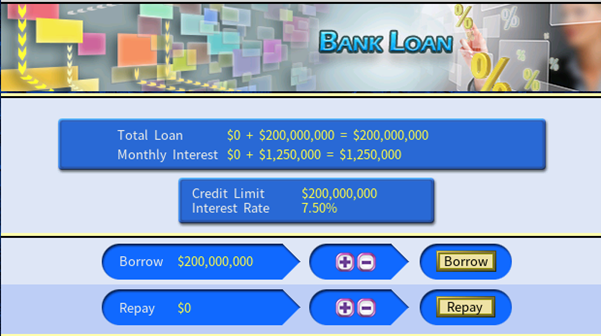
Some things to keep in mind when borrowing money:
- You don’t need to pay the loan principal back; you only need to pay the interest on the loan. You can choose to pay the principal back at any time.
- The loan principle will slowly decrease over time due to inflation, which also shrinks the interest payments, which means that the effective interest rate is not as high as it first appears.
- As long as you have enough assets as collateral you can keep borrowing more money, so as your company expands you can keep borrowing more to expand faster.
- You should also be careful not to borrow too much if you can’t find any profitable opportunities for the borrowed money or if the risk is high.
- You should pay attention to changes in the rate of inflation or the interest rate. If the interest rate is too high and inflation rate is also low then it is probably a bad idea to accumulate more debt and a good time to repay existing debts.
One final note about debt: In the Banking and Finance DLC there are additional options for financing, including Bonds, borrowing from Competitor banks and Credit Ratings. If you are using this DLC then please see the following articles for more details on how these features work:
https://www.capitalismlab.com/banking-dlc/corporate-bonds/
https://www.capitalismlab.com/banking-dlc/bank-loans/
The Stock Market
Another way you can get money is by issuing shares on the Stock Market. The amount of money you can raise with this method depends on your current share price – so it is a bad idea to do this early in the game or if you are in financial trouble as the share price will be too low and this means that you will raise very little capital and your company will become vulnerable to a Hostile Takeover (if any single person or corporation buys 50%+ of your company shares it is game over!).
For instance in this example you can only raise 48 million and the shares are diluted by nearly 25%, this is not a good way to raise capital:
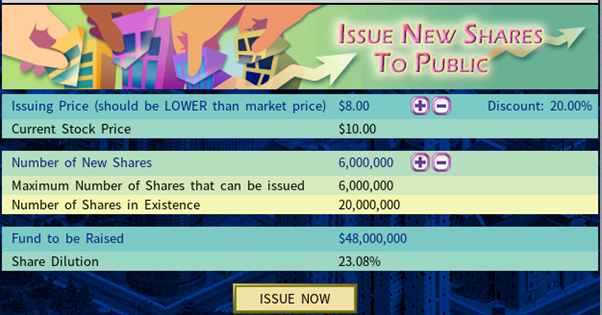
But in the late game when your business is already very profitable and has a good share price, issuing shares can be a great way to raise a lot of money quickly in order to grow further without debt.
Right Sizing your Supply Chain
Make sure that your factories and farms are the right size. If you make your farms and factories too big then you will be spending more money than you need to on both the initial and running costs. Generally speaking the size of the farm or factory required is dependent on the products you are producing and the size of the market you are selling them into.
Some products such as Automobiles (and Car Bodies), Computers or Frozen Meat will require larger factories or farms. While other products such as Glass, Rubber or Plastic usually requires smaller factories or farms.
When producing semi products you should also consider anticipated demand levels. If you are producing Golf Clubs you will only need a small factory to produce the required Steel (it may also be better to just buy the steel from someone else) but Automobiles need a large or medium sized steel factory as those finished products require large amounts of steel and will cost a fortune to buy from someone else.
If you are unsure what size you need then try experimenting a bit, the supply/demand indicators will tell you if your factory or farm is producing too much or too little.
For example in this case this case the yellow bar (supply) is large compared to the orange bar (demand). This indicates that this factory and the factories supplying it might be too large, or it could mean that the retail stores are not selling enough. You will have to check both your factories and stores to see what the problem is:
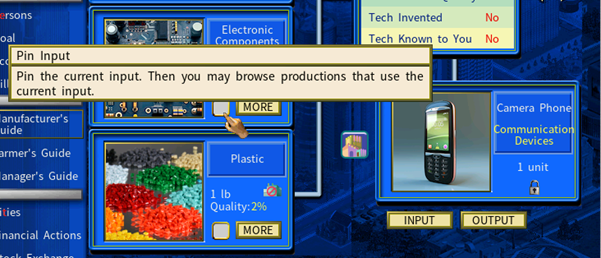
Be sure as well to wait for a little while before making a decision – sometimes the demand may exceed the supply if the inventory of a store or factory is filling up. Factories will always keep producing and purchasing units will keep buying inputs as long as there is inventory space.
Once the inventory is full however the demand will drop – so make sure that the demand is based on actual sales to customers, such as this case below where all of the sales units are unable to sell cars fast enough:
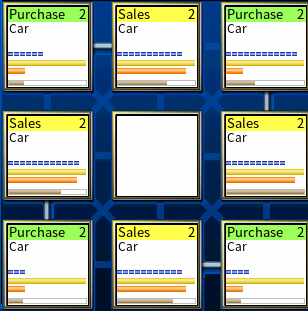
This indicates that it is not the case that the factory is too large, rather that the retail store is not selling fast enough, in which case more stores may need to be built or the sales units need training (to sell faster).
Selling Products
You should make sure that you are selling products at a fast rate. One problem that occurs early in the game is that very few people want to buy your goods. For example when I try to produce cars in this example there are very few customers:
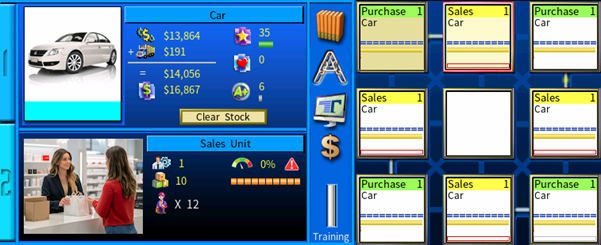
But why do I get very few sales? The problem is that the overall rating is only 6. The reason why the rating is so low is that the Brand is zero, the Quality is only 35 and the price is too high. This combination makes for a car very few want to buy:
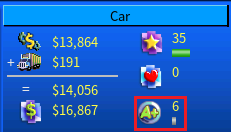
There is a way around this however, if the rating is too low then your best bet is to immediately lower the price (Brand and Quality improvements will take a longer time). You will make less profit per unit but you will ship more units and this will increase your overall profit and start the process of building brand loyalty (when combined with advertising).
In the longer term you should also build up the brand with advertising and improve the quality of the product via R&D and sourcing higher quality semi-products. That way you can charge a higher price again (or sell even more units).
Branding and R&D
Branding and R&D are very important – but it is easy to spend too much or too little on these. Before making any decision on branding/or R&D take a look at the product you are selling – does it have a high rating for tech quality or branding?
For example if you look at Cigarettes you will notice that 60% of their rating comes from branding while only 15% is based on quality and the remaining 25% on pricing:
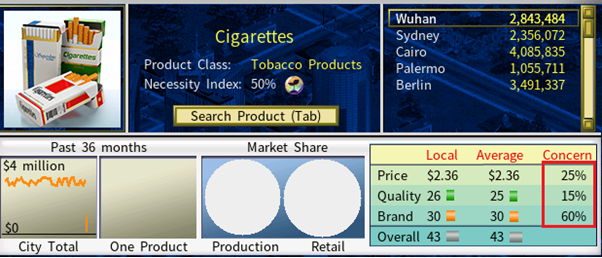
This means that if you are going to sell Cigarettes you should go heavy on advertising and should not bother that much with R&D or producing high quality tobacco.
In contrast all of the Frozen Meats only rely on branding for 20% of its rating (and 40% each for quality and pricing) and therefore you should probably not spend much, if anything on advertising it but instead offer cut rate prices and high quality:
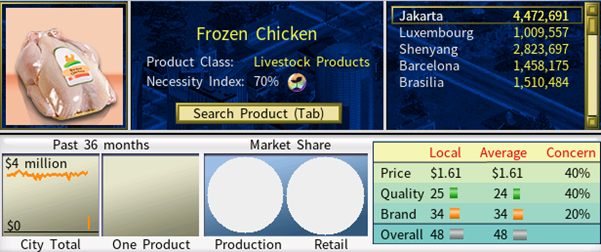
In the case of R&D you should check the above ratings for the product, if quality is an important component then R&D will also become more important, but in addition you should check how much of the actual quality is determined by R&D.
For example 40% of the rating for a Mobile Phone is determined by quality, which means you should pay close attention to it but not only that, 80% of the quality is determined by Production Tech. This makes Mobile Phones a VERY R&D intensive product! The optimal strategy then is to not worry about the quality of the raw materials for your Mobile Phone as these are unimportant; instead you should spend a lot of money on R&D and a modest amount on advertising:
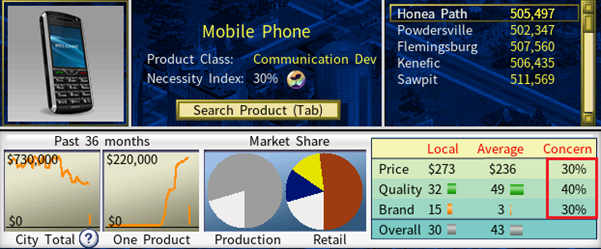
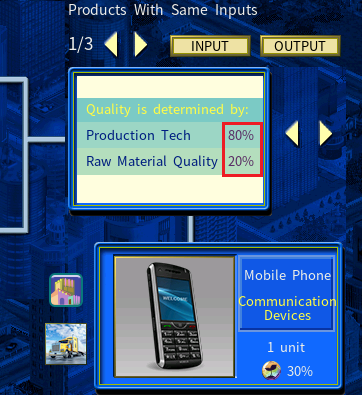
Product Obsolescence
Beware of product obsolescence – depending on what products you are producing you will have to keep up with developing new products and learning to phase out the older products. In Capitalism Lab most products will never go obsolete; however some products in the Automobile, Communications, Computer and Photography categories will go partially or fully obsolete.
If you are unsure of which products will go obsolete check the Manufacturer’s Guide, which will explain which products will replace which and how long it takes for the demand to shift to the new product:

In this example above the Mobile Phone is replaced by the Camera Phone. The speed at which the demand will shift is medium, meaning that the process will take several years. The Max Demand Shift is 100%, meaning that once the transition is complete Mobile Phones will have zero demand, making them completely unsellable at any price.
Demand Shifted only starts once the Camera Phone is invented and is actually being sold in stores. This indicates how much demand has been lost. Once it reaches nearly 100% then the old product is deemed obsolete and you should stop trying to sell or produce it.
To mitigate this problem you should do the following:
1) When you start producing a product such as the Mobile Phone, immediately begin a new product development for its replacement (Camera Phone). The sooner you develop the new product, the sooner you can reap the rewards and leave your competitors behind.
2) If a new product is researched, don’t panic! Demand will only decrease slowly, so you can still make money if you offer lower prices, better advertising or improved quality. None of these remedies will last forever but you may be able to make enough money to catch up or go into a new industry.
3) There is no issue with selling both a new and old product at the same time. New products will take time before they become very popular and the old products can continue to make sales for many years to come.
4) Don’t hesitate to buy technology from your rivals if you are behind. To buy tech, build a headquarters and create a CEO Office (or hire a CTO) and you will have the option to acquire tech:
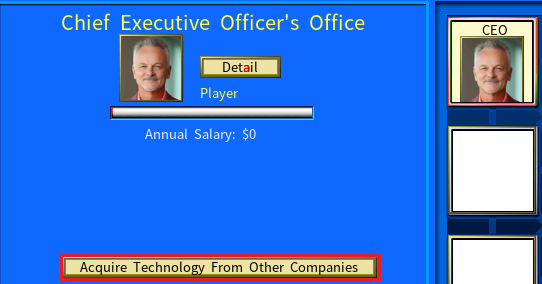
As you can see here there are two companies offering better tech for a Silver Watch. Try the one with the highest value first, it is unlikely to be successful as your competitors won’t want to hand over their best tech to a potential competitor, but sometimes you will get lucky. The company with the second or third best tech is more likely to sell it to you. This will raise the quality of the product and make it easier to catch up using your own R&D assets:
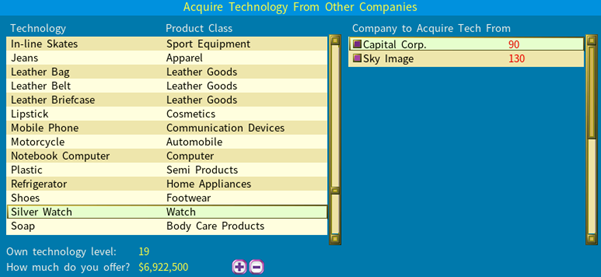
5) If you are going to R&D any product, be sure to check the Unknown Technology menu at the top of the Manufacturer’s Guide. It will give you useful information about what has been invented and what technology or date is required to unlock another technology (for example Smart Phones need Camera Phones to be researched and they can only be researched after the year 2000):
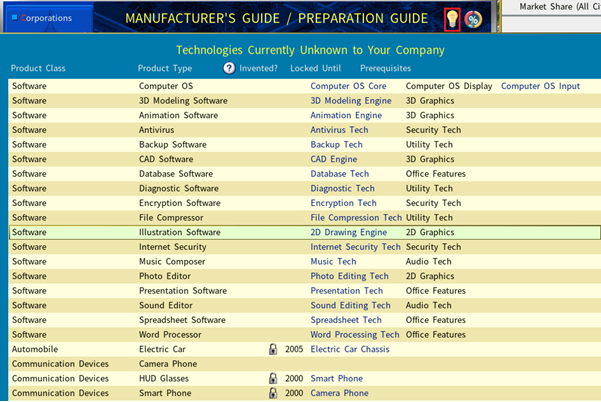
6) Finally to enable maximum R&D speed you should maximise the training at your R&D Centres and, if the budget allows it you should hire a CTO and take advantage of their skills (more on Senior Executives and Training in the next sections).
Training
Training is a great way to boost the productivity of your firms and to allow them to make you more money. When a firm is first created all of the units will start at Level 1 (unless you have expertise or senior executives, more on this in the next section) and with training they can be boosted to the maximum level 9.
There are two ways to train your employees:
- Setting the training budget for an individual firm.
- An Intensive Training Program.
Per firm training tends to be inexpensive but it is also slow, taking months for each level increase. However since it is cheap to perform you are generally better off using this method of training when you first start the game. Setting a training budget can be performed in the firm itself using the slider (highlight the bar if you want to see what it is costing you per month):
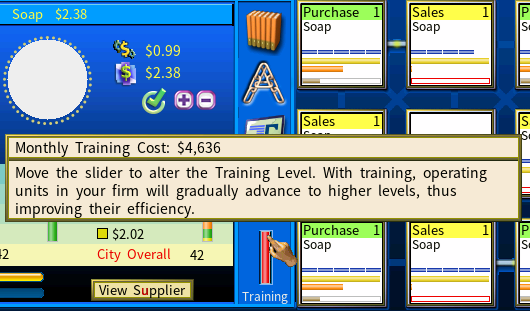
You can also set the training budget for all firms at once via the Human Resources Department in your Headquarters:
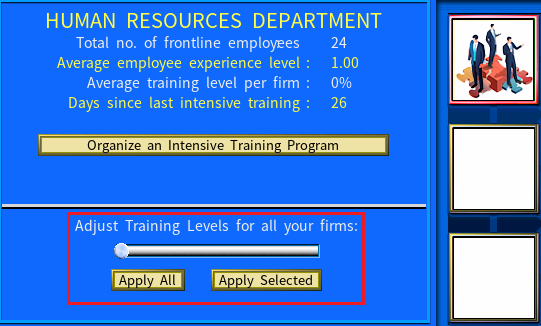
If you have a lot of money and you want to increase the level of your firms instantly, you can use the option: Organise an Intensive Training Program. This is expensive and it will be applied to all of your employees that are below level 9 all across your corporation (you cannot pick and choose which firms will get the intensive training or not):
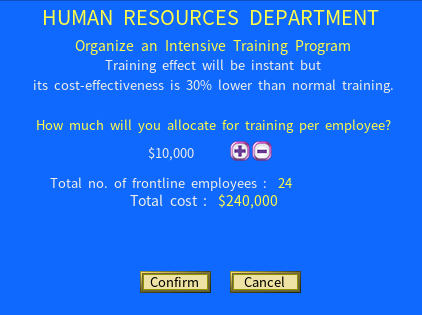
This is a good way to boost the productivity of your firms in circumstances where a rapid increase in production/sales is needed (such as after inventing a new product with high demand).
Senior Executives and Expertise
Senior Executives are any people you can hire to manage the high level functions of your corporation. The executives that you can hire in Capitalism Lab are:
- Chief Operating Officer (COO)
- Chief Technical Officer (CTO)
- Chief Marketing Office (CMO)
There is also the CEO (Chief Executive Officer) but this role is always occupied by you and cannot be changed.
Senior Executives can be very useful as they can give your corporation bonuses in research, marketing, manufacturing, etc. as well as manage some aspects of your corporation for you such as advertising or marketing. However they are also very expensive to hire and will demand more money from you as your corporation becomes more profitable.
To hire a Senior Executive you will need to build a Headquarters and the relevant office for that position:
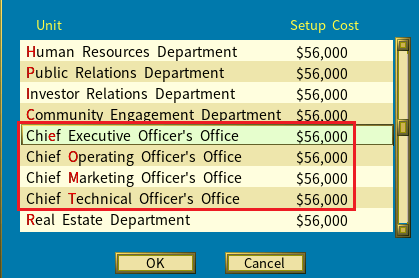
Once you have setup their office you will then need to hire an appropriate candidate. Let’s use the CTO as an example:
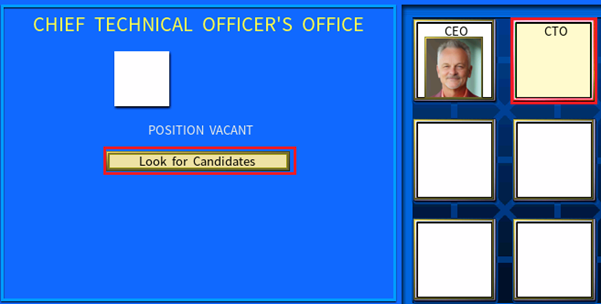
For our CTO you will want a candidate which has a high level of expertise in Research and Development, the higher this level, the higher the bonuses you will get for Research and Development (however they will cost more to hire):

Once you have hired your CTO you will have information on their current annual salary as well as the bonus they provide to your R&D centres.

An expertise of 90 means that the R&D centre units will have a level of 5 when you first build it, saving many years of training and allowing you to research products much faster than without a CTO, such as this Camera Phone only needing 3 years of development:
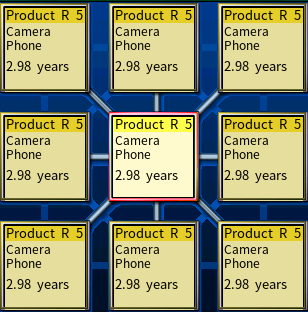
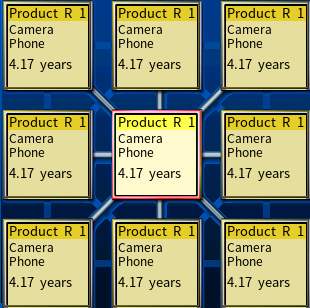
A word of caution: a CTO may try to change the current research project or the training level of your R&D Centres. If you don’t want this then you can change the Management Policies of the CTO (you can also terminate their employment if you don’t want them anymore):
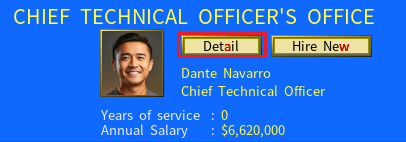


You can also fine tune their level of control over advertising and branding as well as what media firms they use:
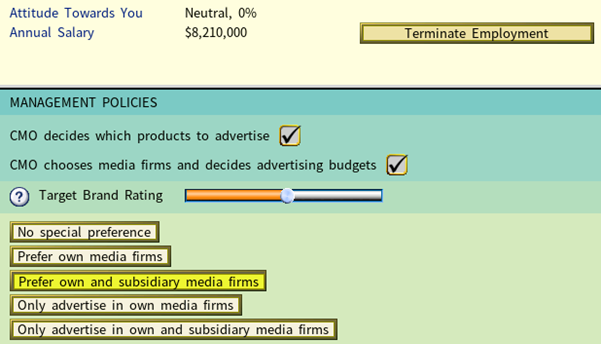
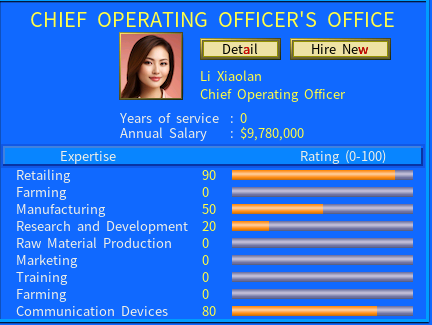
In the above example any retail store will have highly trained sales and purchasing units, any factory will have more highly trained manufacturing and sales units and any R&D Centre researching Communication Devices will have a bonus speed in the R&D units.
If the COO has expertise in Farming and Raw Materials then the bonuses would also be applied to those firms as well, making them more efficient.
The COO can also control many aspects of your business such as what to sell in the stores and at what price, so you may want to tell them which firms they are allowed to control or not control as they could make decisions that you don’t want:
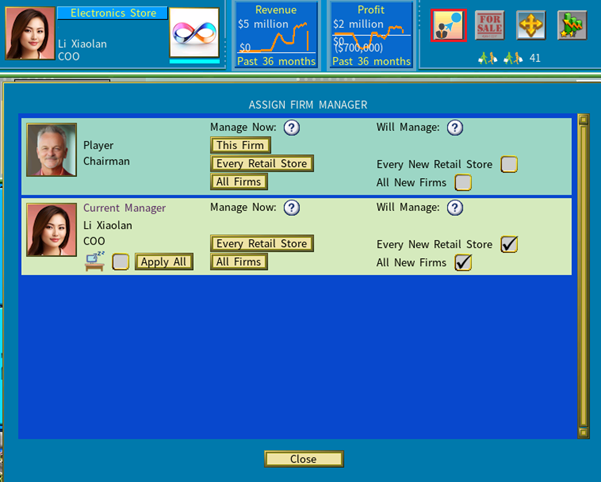
The last and most important senior executive is the CEO, which is your in game person. While it is not possible to change the CEO there are two things that you can do with the CEO:
You can set your personal salary at the headquarters, which is a good way to accumulate personal cash without paying dividends to other shareholders:
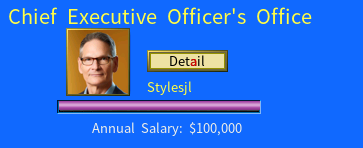
The other is that you increase your own expertise with Knowledge Points (the effects are the same as the COO above):
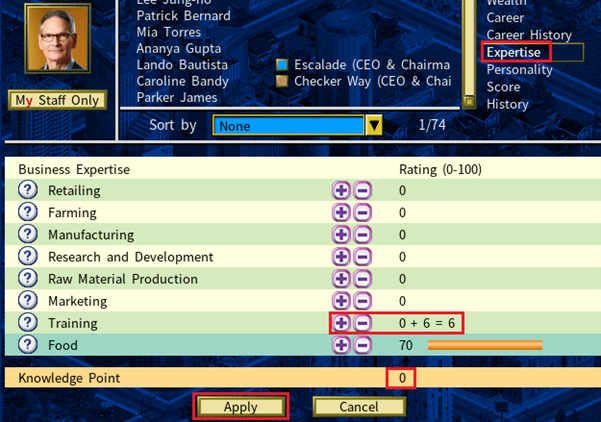
Knowledge Points can be accumulated by fulfilling goals or assigned to you at the start of a game.
Finally in the case of the COO and CEO, you may want to pick and choose which executive is in control of a specific firm, as their personal expertise is what determines the levels of the units in the firm. So if the CEO is an expert in manufacturing, put them in charge of the factories. If the COO is an expert in retail, put them in charge of the retail stores, etc.
Raw Materials vs Farm Products
Raw Materials and Farm products are similar to one another in that they are both the basic building blocks of various finished products; however there are some important differences between the two in terms of how they will interact with your supply chain.
The major differences are as follows:
-
- Farms can be constructed almost anywhere while Raw Materials require specific locations on the map, this means that you have limited choices to plan the raw material aspect Raw Material of your supply chain.
-
- Farms are cheap to build compared to Raw Materials sites, which means that supplying your own raw materials is usually not a good idea unless you have a lot of money and a high demand for raw materials.
-
- Farms will never deplete their resources while raw materials will run out and a new site will need to be selected. This requires you to plan ahead with recurring expenses.
- If you increase the training level for farms, the quality and quantity of the farm products produced will increase all the way up to 100, making training on farms important for improving the quality of your products. The same does not apply to raw materials; the quality level is fixed based on the plot of land you built it on.
Example of how training affects the quality of farm products.
The Level 1 units in a farm have a quality of 30:
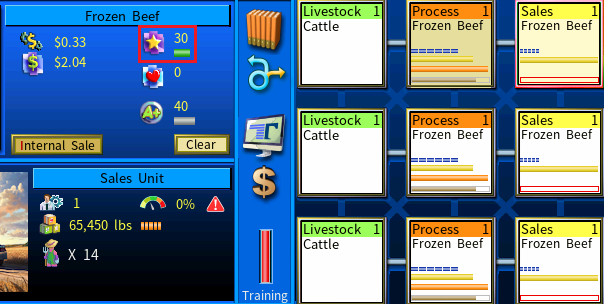
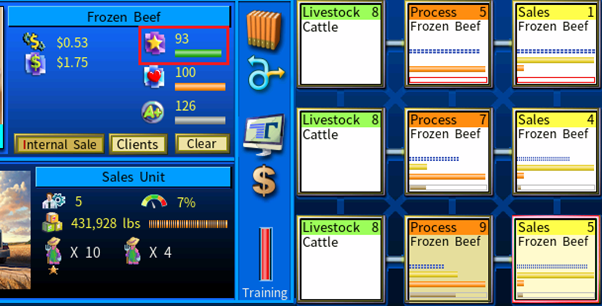
The quality of raw materials however is set by the location, training cannot change it (also, the higher the quality, the higher the land cost):

